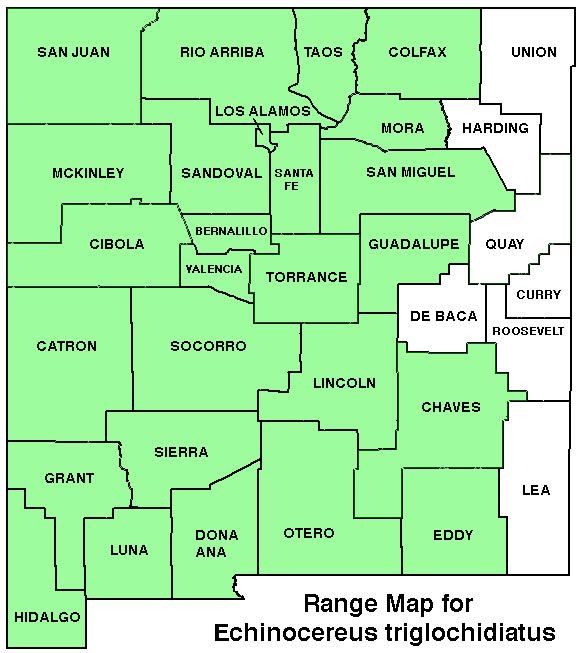WILDFLOWERS OF NEW MEXICO

This beautiful hedgehog cactus with rigid orange-red to dark-red flowers is widespread throughout most of the state. The erect, cylindric stems, 2–5 inches wide and 2–24 inches tall, grows singly, as a cluster with only a few branches, or a mound several feet across with numerous branches. Note the stems have 5–8 ribs with widely separated areoles with only a few radial spines, and a central spine, if present, that feels angular to the touch.
FLOWER: April–June. Funnel-shaped flowers, 1–2 1/2-inch wide (3–7 cm), develop on the sides of the stem and have stiff, rounded petals (tepals), brilliant red with pale to white bases, and a green stigma that stands above the cluster of filaments with pinkish-purple anthers. Fruit is egg-shaped, 3/4–1 1/2-inches long (20–38 mm), fleshy, green maturing red with white pulp, and with clusters of tiny spines until ripe.
SPINES: Areoles have short, white felt, 1–10 radial spines, the larger ones flat or angled, and no or 1 central spine, angular in cross-section.
HABITAT: Sandy, rocky soils, mesas, canyons, foothills; desert grasslands and scrub; brushlands, pinyon-juniper-oak, ponderosa-oak woodlands.
ELEVATION: 4,500–9,500 feet.
RANGE: AZ, CA, CO, NM, NV, TX, UT.
SIMILAR SPECIES: The E. triglochidiatus complex, with several varieties, originally included Claret Cup, E. coccineus, which has 1–4 round central spines. The closely related Arizona Claret Cup, E. arizonicus, in sw NM, has stems that reach 4–6-inches wide with 9–10 ribs.
NM COUNTIES: Widespread, except eastern border counties, in low- to mid-elevation, dry habitats: Bernalillo, Catron, Chaves, Cibola, Colfax, Dona Ana, Eddy, Grant, Guadalupe, Hidalgo, Lincoln, Los Alamos, Luna, McKinley, Mora, Otero, Rio Arriba, San Juan, San Miguel, Sandoval, Santa Fe, Sierra, Socorro, Taos, Torrance, Valencia.
NOTES: Unlike most cacti with yellow to purple flowers with weak, pointed petals adapted for insect pollination, claret cups and kingcups have bright red flowers to attract hummingbirds, rounded petals rigid enough for a perch, and remain open 2–3 days. The flowers are sized to fit hummingbirds heads, while plants with red, tubular flowers are sized to fit hummingbird bills.

KINGCUP CACTUS, CLARET CUP
ECHINOCEREUS TRIGLOCHIDIATUS
Cactus Family, Cactaceae
Perennial cactus

THE CONTENTS OF THIS WEBSITE ARE COPYRIGHTED AND CANNOT BE USED
WITHOUT PERMISSION OF GEORGE OXFORD MILLER



Widely separated areoles have 1–10 radial and 0–1 central flattened to angular spines.





Large-stemmed variety common at White Sands Missile Range.

EMAIL ME
Specialized pollination: The rigid, red tepals of kingcup and claret cacti make perfect landing pads for hummingbirds, and the cacti flowers are sized to fit hummingbird heads. Bees also pollinate the nectar-rich flowers.